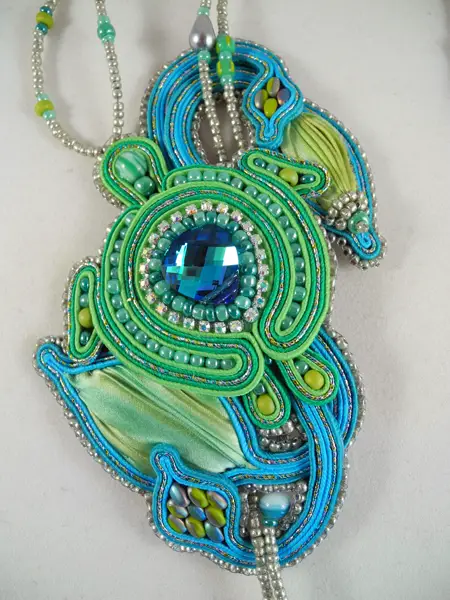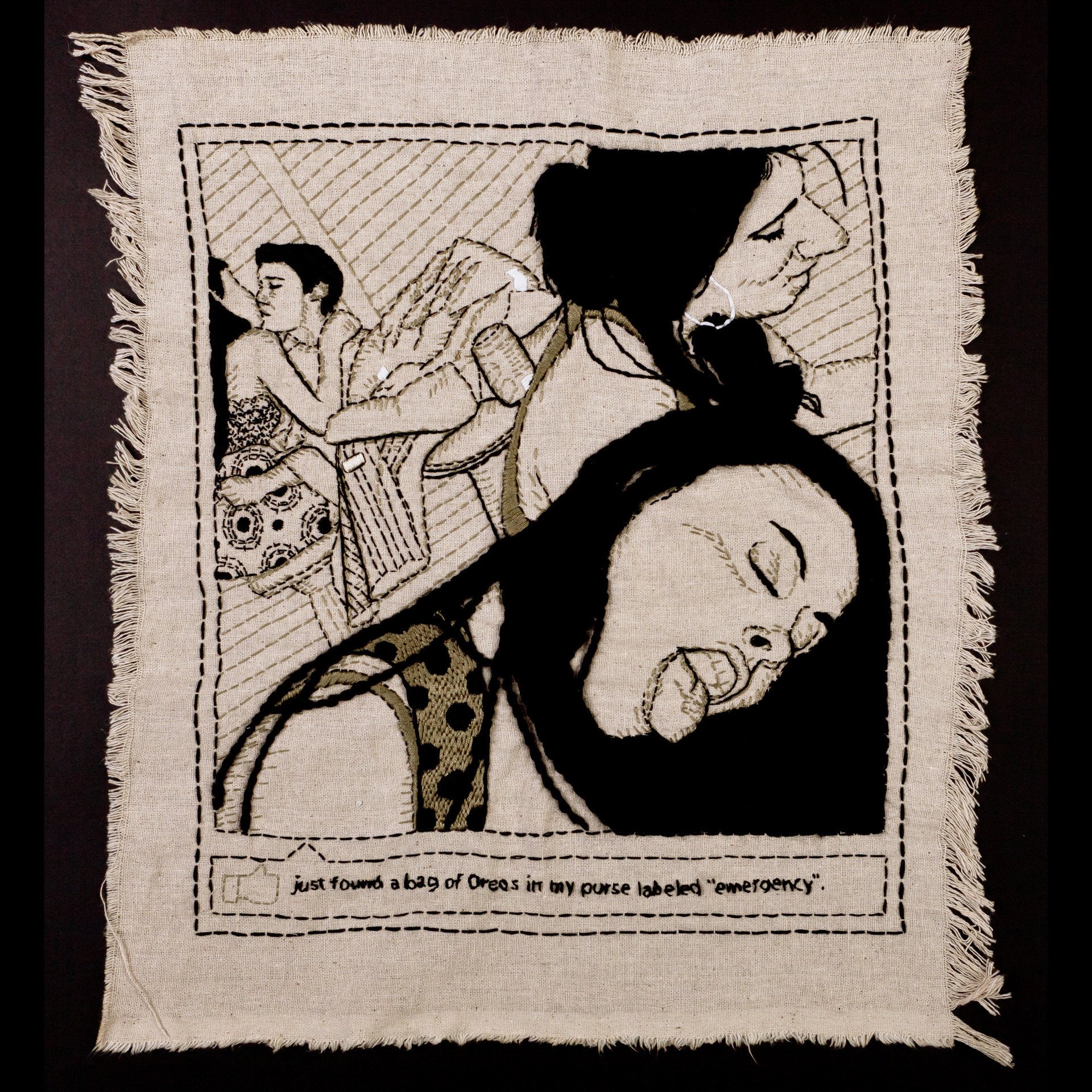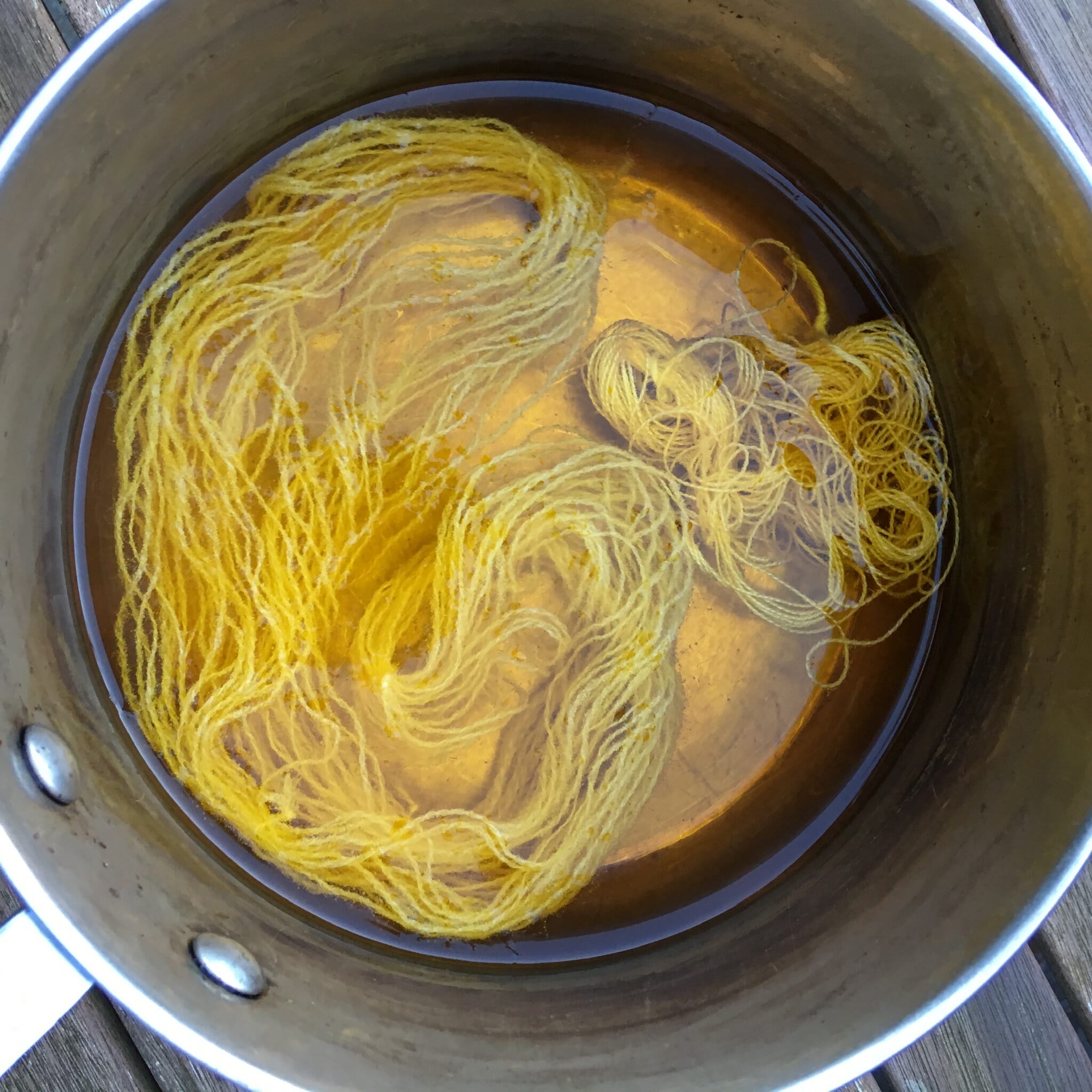A Google search for “soutache” led me to Amee K. Sweet-McNamara. Amee’s style and color sense hooked me. Amee herself keeps me returning and inspires me to explore some new techniques. Grab a cuppa, and let’s sit down and chat with Amee.
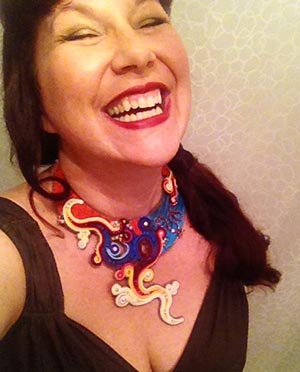
Name: Amee K. Sweet-McNamara
Business name: Amee Runs with Scissors
Location: Manchester, NH, USA
Career and Business
If I had to come up with a title for you, Amee, I might call you a soutache-bead-embroidery arteachpreneur. If pressed, what would you call yourself? (Yes, I’m pressing.)
An Unabashed Obsessive Dabbler.
You weren’t always this. Career-wise, what were you before you became a soutache-bead-embroidery arteachpreneur?
I was a professional Interior Designer for over twenty-five years. The last fifteen-plus years of my career were spent managing the design department of a full-service residential remodeling company.
What prompted your career change?
The company I worked for was wonderful and I am very, very proud of the work I helped create during my career – redesigning people’s homes often means dramatically improving their lives and that can be exciting. As my career wore on, however, I became hungry for a richer color-palette, a greater degree of decoration. Spending countless hours trying to help clients make the evidently-earth-shattering decision between beige and ecru had taken a toll on my creative spirit.

Practically speaking, how did you make the career change, and what was it like to start over on a new path? What skills from your other career(s) do you find invaluable?
I dove-tailed from one career to another. My boss understood my creative drive and actively encouraged me when I decided to go back to art-school. I started making jewelry and selling in galleries. I juried into the League of New Hampshire Craftsmen. Then I started teaching and selling supplies online. I wrote a book (Soutache and Bead Embroidery – Kalmbach). I cut back from five days a week at my regular job to four – something I could not have done had I not been working for someone who was as deeply committed to the needs and development of his employees as he was to his own life and business.
Ultimately, I took the leap and resigned from the remodeling industry. January 1st, 2014 was the first day of my adult life during which I could no longer count on a “paycheck.” It was terrifying and exhilarating. I consider myself exceptionally fortunate to have had such and sympathetic employer.
Starting over was a little bit like my first sky-diving experience; you’re in a sort of short-radius bubble. All you can think about is your altimeter, when you’re supposed to pull your ripcord and the fact that the wind is shoving itself up your nose at a 130 mph. You don’t see the ground, the sky, the horizon – you’re completely focused on your immediate survival. My first year in business felt a lot like that – there was no long-range planning – just “how much money do I need to make to cover rent? How much do I need to make to pay the electric bill?” People who were cheering me on would say, “You’re doing it, Amee – you’re Running with Scissors!” and I would sort of laugh and say, “No – I’m not running… I’m not even walking… every ‘step’ is simply catching myself before I fall on my face.”
There are many things I developed during my old career that I find invaluable: A broad-range skill-set including public speaking, creative marketing, a basic understanding of financial documents, knowing what and when to delegate. Managing people is crucial – leveraging their talents and understanding that it is easier to custom-fit a job to a good employee than it is to mold a good-employee into a job. Time-management and an ability to meet deadlines are very important to me. An understanding of the value of every customer and every student. My old boss used to say, “Every lead (contact from a potential client) is a like a drop of water in the desert.” I truly believe that. I take great pains to answer every email, every phone-call as quickly and thoroughly as possible. When I hear other art-professionals complaining about “stupid questions” or “annoying customers,” I kind of roll my eyes… These are problems we are privileged to have!
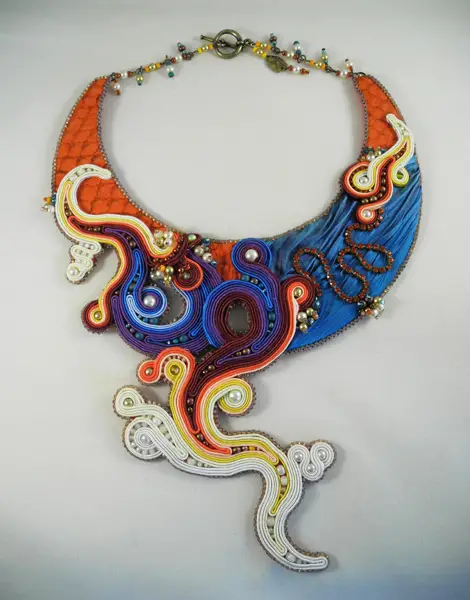
Most of the Funk Files interviewees are young: in school or fresh out of it. What are the advantages and disadvantages of entering the art world later in life?
In the simplest of terms – perspective. When you’re young, every problem and crisis is new. It’s almost always met with a very emotional fight-or-flight response. But after you’ve been around the block a few times you not only have the ability to say, “Oh, yeah… this sucks but I’ve been here before and I know how to handle it,” you also probably have some very low “low-bars,” as in, “Oh, yeah… this sucks but at least it doesn’t suck as much as that one thing that one time!”
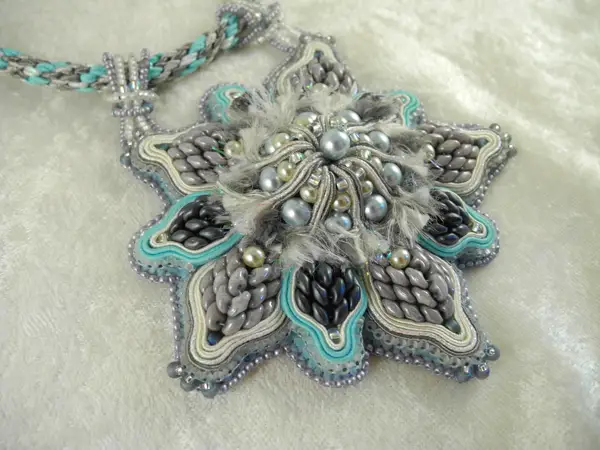
You juggle a lot: You teach, write books, create works of art to sell, and maintain a website that offers, among other things, art supplies. Do you have a favorite part? And how do you do it all?
My favorite part is “ALL OF IT!” I essentially invented my own job so, if there’s anything I really hate, that’s on me, right? Early on, I delegated the things I enjoyed the least or caused me anxiety. Data entry for my financials for example – I would seriously rather gouge out my eyes with a shrimp-fork than sit behind a computer and enter numbers into QuickBooks. I know how to do it. And I understand all the categories. BUT. I. HATE. DOING. IT. So, I have a bookkeeper come in once a quarter and do it. While she does that, I sit on the sofa and make a piece of jewelry completely content in the knowledge that the profit from that one piece of jewelry will pay for her services. It’s a win/win as far as I’m concerned.
Pulling craft-supply orders and kit-building are other things that I have delegated. I don’t hate doing those things but they’re simply not the best use of my time anymore. I have an amazing staff of Studio-Assistants – bright, happy, efficient young women – and they now do those things far more efficiently than I ever could.
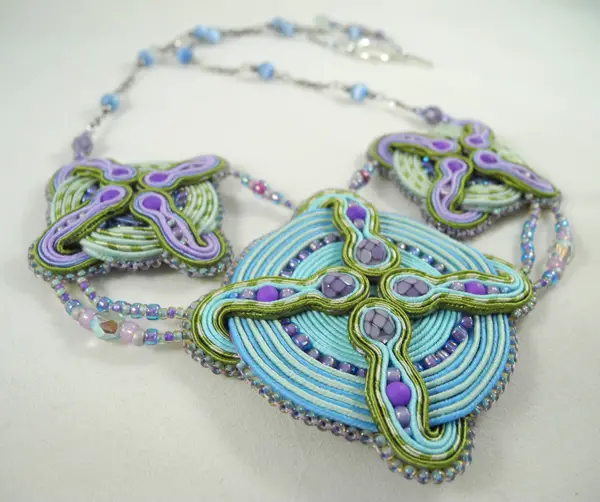
My Studio Manager, Sarah, and I share marketing duties. We both work in Photoshop, write Constant Contact ads for sales, post to social media, etc. I know that – ultimately – this too will need to be redirected to a specific person within the company but I’m kind of putting it off… mostly because I really enjoy doing it…
I love teaching and I love selling my work. I will never give those up although I do get help; I almost always have a Studio Assistant with me in the booth at craft-shows and – for particularly big classes – having an extra set of hands to help students is a huge relief.
At the end of the day, however, the passion continues right where it began – having my hands in the work, designing new pieces, creating new things. It’s all about the color and the materials for me. I never tire of it and the fact that I’m busy with so many other things simply keeps the love alive.
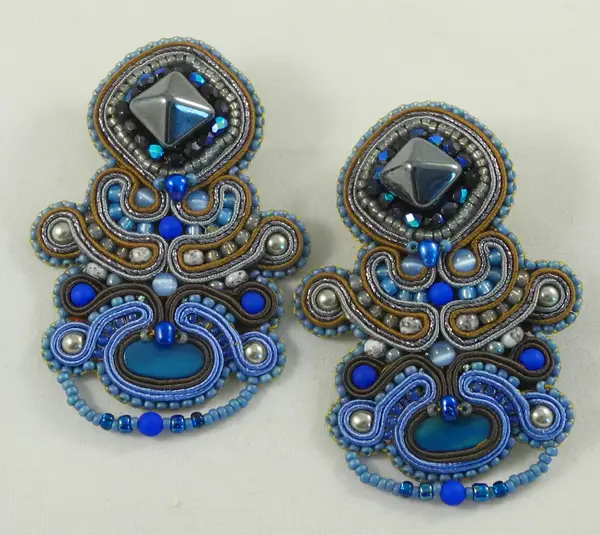
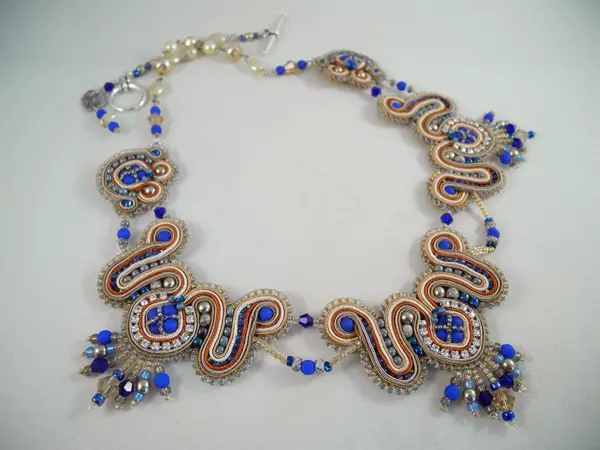
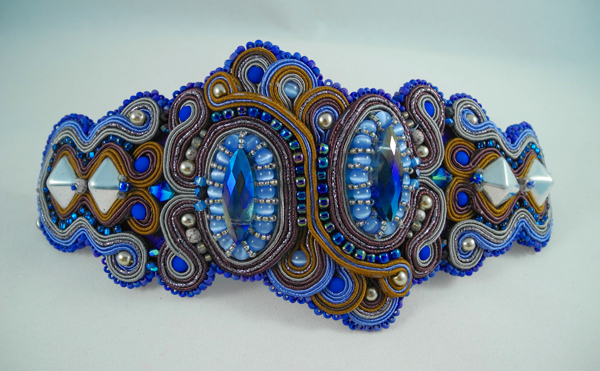
The Art
How did you come to choose soutache, beads, embroidery, and jewelry instead of, say, macaroni cat furniture or something else entirely? And how did you learn about the materials and techniques? Is there any single person, item, or event that guided you to this path?
Oh, no! Wait! Macaroni cat furniture was an option?! I want to change my choices!…
Ah, I’ve told this story so many times, it’s become like my own personal fable… I feel like it should start, “Once Upon a Time…”
Once Upon a Time, I was normal. Just your average, artsy-craftsy kind of girl who made “stuff” in her spare time. One day, I was at the fabric store buying material to make a hat (I went through a serious, soft-hat phase for awhile). I was standing in line to check out, minding my own business when my eyes landed on the magazine rack. The December 2003 issue of Bead & Button Magazine featured a photography of Sherry Serafini’s work – a magnificent necklace that reached across the store and instantly transformed me into a bead-zombie. I staggered to the rack, picked up the magazine and started reading while I was in line. Paid for my purchases. Continued reading while driving home, magazine open on the passenger seat next to me. Got home and began running around collecting up “stuff” to begin my first bead embroidery piece. Never made the hat.
And so it began. I always thought that – when I finally got to meet Sherry – I would take her by the shoulders and shake her, yelling, “YOU did this to me!!!” (I didn’t – she’s way too nice to do that to.)
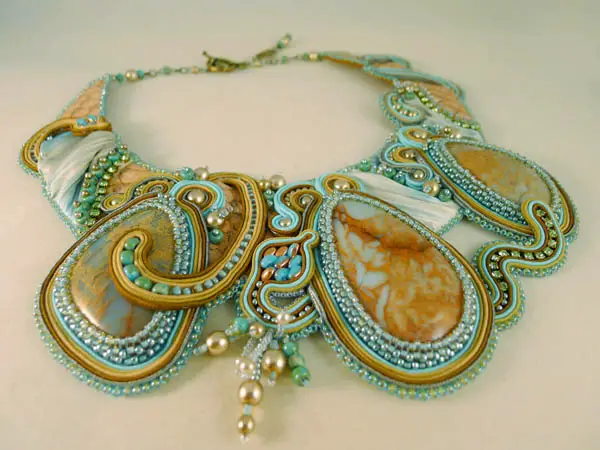
As I fell more and more deeply in love with beads and more and more profoundly out of love with remodeling, I started thinking about a career change. The world of bead embroidery – it seemed to me at the time – was pretty well all sewn up. Between Sherry Serafini and Heidi Kummli, I couldn’t really see that there was a lot of space for another national instructor in that specialty (then Kinga Nichols came along and totally proved me wrong but I digress…). So, I began looking for something else… I didn’t know what… something that was bead embroidery and wasn’t bead embroidery.
We’re going back quite a few years here… It’s maybe 2005? 2006? I’m googling “bead embroidery” looking for some kind of inspiration and I’m deep into Google – like fifty pages back. And suddenly, there’s this weird, blurry photo of something I don’t really recognize… is it bead embroidery? Is it polymer clay? Everything that’s written about it is in some language I don’t recognize – Polish? Russian? I don’t know. But every so many sentences there is a word I do recognize – “Soutache” – which I know from my garment-sewing days. I begin searching “soutache jewelry,” “cord jewelry,” “Russia-braid jewelry.” Not a ton of results at the time but enough to intrigue me. I started trying to contact the artists when I could track them down. Most didn’t respond (I’m assuming due to a language barrier) but I did get one response… the artist said, “This is a patented process and we don’t teach people. Especially Americans.”
Game on.
I drove back to the fabric store (the scene of the crime) and bought every color of soutache they had (black and white). I then went home and spent three months figuring out every possible wrong way to work with this stuff. I finally hit on a technique that worked for me. The rest just unfolded.
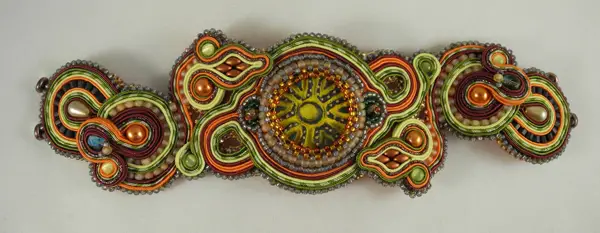
One of the things that drew me to you was your affinity for bright colors. What’s behind your sense of color? Did you use such bright colors in your Interior Design work? Do you make an effort to change up your color choices, and if so, how do you do that?
Color and color-combinations have fascinated me since I was a little girl. Some of my earliest memories involve simply handling volumes of colorful “stuff” – buttons, ribbons, crayons, paint chips. I didn’t always know what I wanted to do with those things but I wanted them… like a little baby dragon already starting to collect her hoard…
When I was working as an Interior Designer, I often tried to coax my clients toward brighter colors and some of them happily took the leap. But there were many, many – sigh – MANY staunch members of the “Beige or Ecru Collaborative.” I suppose that the gravitational pull I feel toward bright color combinations is, in some way, an attempt to slake a twenty-five year thirst… and it’s gonna take some time…
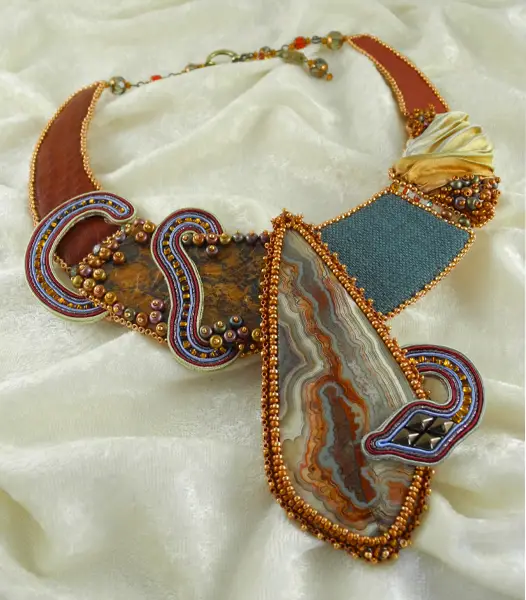
You claim to have a “more-is-more” mentality, and you like to combine seemingly disparate elements. Explain this, please—and can you give us an example? Does this blending of disparate elements generally work out, or are there times when it simply doesn’t work. If you have a disaster story, we want to hear it!
I’ve heard snooty-arty types say things like, “The definition of good design is the removal of everything that is unnecessary.” (This is usually uttered in a low tone through locked jaws while swirling a glass of la-dee-dah-brand wine.)
To this, I say vehemently, “Ppppllllfft.”
“More-is-More” means simply “I like to have a LOT of pretty stuff to look at.” I like to go into a space and have my eyes taken on a journey, resting briefly on a beautiful object before moving on to the next beautiful object. This can mean “busy” but it does not necessarily mean “cluttered” – objects need to relate to one another by virtue of their colors, shapes or textures. When I make jewelry it’s the same thing on a smaller scale. And those relationships are just as important; I love to see the scaly texture of Fish-Leather, for instance, being echoed by the scalloped texture of an old piece of lace trim or – better yet – offset by the richness of velvet. There are no real “disasters;” there are occasionally “wrong turns” that either take me someplace completely new or are simply remedied by a U-turn.
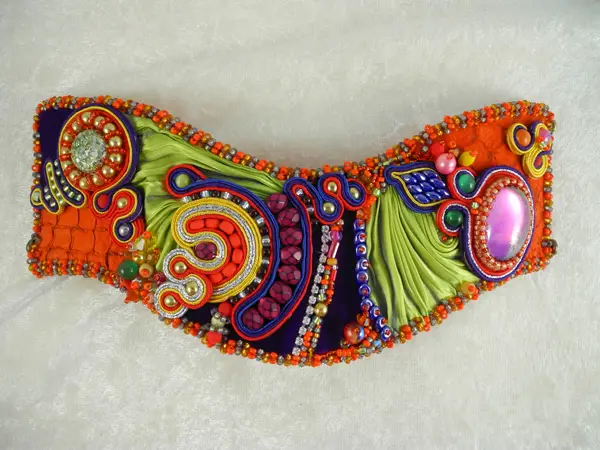
What advice would you give to someone who wants to be more creative with his/her art or craft?
People can get bogged down by their “go-to” color-schemes and shapes. The best way to get outside your creative comfort zone is to get somebody (and it can really be anybody) to give you an “assignment”- some creative work task you would never dream up yourself; “Design a business card that has nothing on it but your phone number.” “Reach into this bag, pick out three things without looking at them and incorporate them into a piece of work.” “Open a magazine at random and work in the colors you see on the page.”
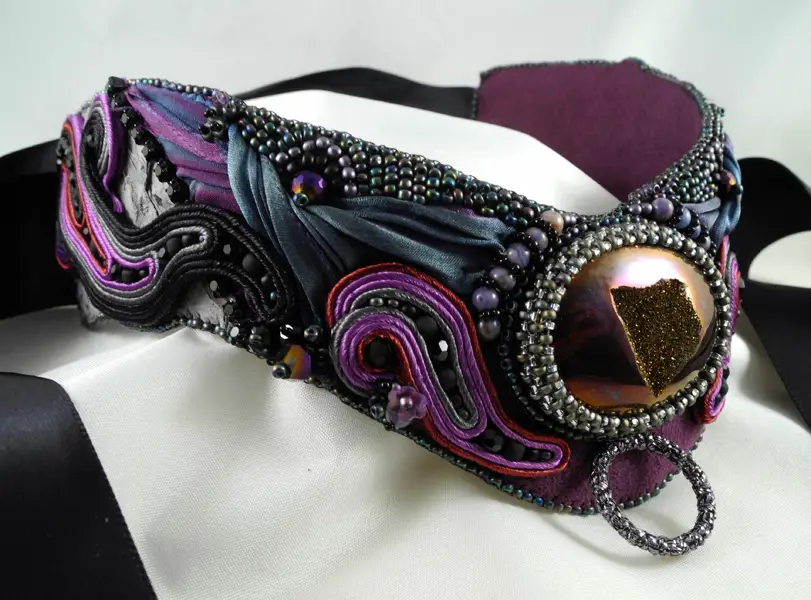
Describe your dream commission. What and for whom is it?
Oh, this is an easy one… I want to make a dress for Queen Latifah – it would be based on a larger, collar-style necklace but the dress would be attached and flow from the necklace. It would be fabulous… if only she knew…
Where to Learn More
What’s coming up for you; where can we see more of your work; how can we connect with you to take a class?
I have a really fun, busy, multi-faceted business model so, there’s always something going on – craft shows, classes, TV appearances, etc. Probably, my biggest “new news” is that my book, Elegant Soutache (Lark/Sterling) will be available in October. Folks can pre-order the book as well as find schedules, links, craft-supplies, free videos and more on my website; www.ameerunswithscissors.com.
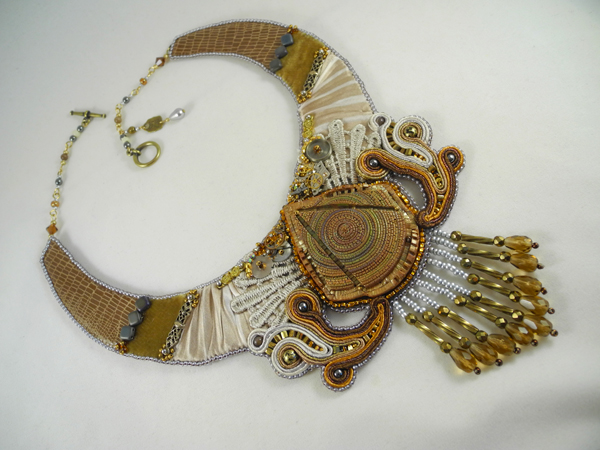
Rapid-fire Round: (Don’t think too hard about these.)
Favorite material to work with: Soutache! No, wait… Shibori ribbon! No, wait…
If your jewelry were cataloged with books, what genre or category (besides art) would it be? Textile craft
Your next piece must be a single color. What color do you choose? Olive green.
You’ve been selected to participate in a show that combines embroidery with performance art. Describe your piece for the show. I love circus and magic acts… It would be wonderful to have the freedom create a very large “illusion box” upholstered in rich textiles – something large enough for performers to get into.
Favorite tool in your arsenal: Small, curved-blade Ginger scissors.
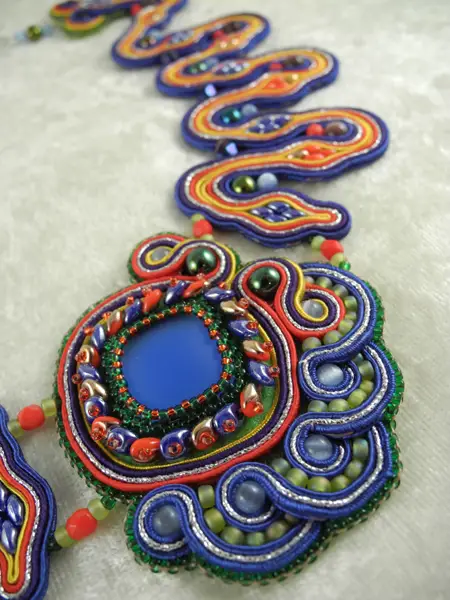
You can teach a class anywhere in the world and it will be packed with enthusiastic and creative students. Where will you go? Barcelona. Hands down. Gotta see the Gaudi architecture before I die.
You’re creating a piece of jewelry for an animal. What is the animal, and what do you create? Well, it would have to be for my pug, ChihNii. Mostly because she’d never forgive me if I created something spectacular for some other animal. I think I’d do a full armor for her a’la the “Armored Bears” from the book, “The Golden Compass.”
Favorite book you’ve read recently: “The Little Paris Bookshop” by Nina George
You must include something edible in your next piece. What do you use, and how do you incorporate it? This is probably a cop-out but I’m thinking “licorice whips” simply because they would blend in so well with the soutache. I’d just stitch over them with thread or even through them like I do twisted cord.
A celebrity wears a piece of your jewelry to an awards show, and you receive fame, fortune, good health, fitness, and cake for life. Who is the celebrity and what does s/he wear? Still Queen Latifah – total red-carpet gown – something with a strong necklace/collar component but draped low at the bust and baring her shoulder entirely… I picture this in a rich, warm green-to-brass combination… with lots of crystals and freshwater pearls.
